Overview
In the fast-paced world of software development, coding challenges are a common hurdle for developers. How can these obstacles be overcome? The Software Development Life Cycle (SDLC) methodology offers a structured approach, guiding developers through phases from planning to maintenance. However, in today’s rapidly evolving landscape, adapting to modern trends is essential. This is where tools like Kodezi come into play. Kodezi addresses these challenges with features designed to enhance collaboration and efficiency.
By integrating Agile methodologies, Kodezi allows teams to respond swiftly to changing requirements, fostering a more dynamic development environment. Furthermore, the platform's collaborative tools streamline communication, ensuring that everyone is on the same page. This adaptability not only improves productivity but also enhances code quality, leading to faster delivery times.
Imagine a scenario where your team can seamlessly integrate feedback and iterate on code without the usual bottlenecks. With Kodezi, this vision becomes a reality. The benefits are clear: improved productivity, higher quality software, and a more efficient workflow.
Are you ready to elevate your coding practices? Explore the tools available on Kodezi and discover how they can transform your development process. Embrace the future of software development with confidence.
Introduction
In the rapidly evolving landscape of software development, developers face numerous challenges that can hinder their productivity and the quality of their applications. Understanding the Software Development Life Cycle (SDLC) is paramount for creating high-quality applications. This comprehensive framework outlines the essential phases—from planning and requirement gathering to testing and maintenance—that guide developers in delivering software that meets user expectations and industry standards. Furthermore, as organizations increasingly adopt methodologies like Agile and Iterative approaches, the importance of structured processes becomes even more apparent.
Enter Kodezi, a tool designed to address these challenges effectively. With features that streamline coding practices, Kodezi empowers developers to navigate the complexities of modern software development. Imagine being able to enhance your coding efficiency while ensuring that your applications adhere to industry standards. In addition, Kodezi offers automation tools and integrates security measures, providing a robust solution for developers looking to optimize their workflows.
The benefits of using Kodezi are clear: improved productivity and enhanced code quality. By leveraging this platform, developers can focus on what truly matters—delivering exceptional software. This article delves into the intricacies of the SDLC, exploring key phases, models, and best practices that empower developers. Are you ready to explore the tools available on Kodezi? With insights into automation and security, this exploration provides valuable guidance for navigating the complexities of software development.
Kodezi | Professional OpenAPI Specification Generator - AI Dev-Tool: Streamline Your SDLC Process
Developers often encounter significant challenges in optimizing their software development life cycle (SDLC) processes, which relates to the SDLC methodology meaning. Kodezi emerges as an essential asset, equipped with a Professional OpenAPI Specification Generator that automates API documentation generation, ensuring compliance with industry standards. This automation not only reduces the time spent on documentation but also fosters improved collaboration among team members by providing clear and consistent documentation throughout the development cycle, which reflects the SDLC methodology meaning. Furthermore, the integration of Kodezi into the SDLC facilitates smooth transitions between phases, ultimately enhancing software quality. Organizations that implement automated documentation can expect a faster return on investment, with 78% anticipating returns within six months. In addition, case studies indicate that automated evaluations can reduce developers' feedback response time by up to 80%, leading to shorter development cycles and quicker time-to-market for new features.
Similarly, Kodezi's suite of developer tools, including the Kodezi CLI, empowers teams to auto-heal codebases and streamline their workflows, enhancing overall programming productivity. Kodezi also enables the automatic generation of OpenAPI specs and the creation of Swagger UI sites for testing APIs, which are crucial for modern development practices. As trends in API documentation automation continue to evolve, Kodezi remains at the forefront, enabling developers to improve their workflows and provide exceptional solutions.
Are you ready to transform your coding practices? Explore the tools available on Kodezi's platform to elevate your development experience.
SDLC Definition: Understanding the Software Development Life Cycle
The SDLC methodology meaning serves as a systematic framework that delineates the stages involved in creating applications, ranging from initial concept to deployment and ongoing maintenance. This process typically encompasses several crucial stages:
- Planning
- Analysis
- Design
- Implementation
- Testing
- Deployment
- Maintenance
Each phase is vital for ensuring that the final product meets user requirements and adheres to quality standards, ultimately facilitating successful software delivery.
Recent trends reveal a notable shift in SDLC methodologies among developers, with smaller teams demonstrating a 78% preference for Agile approaches. This inclination underscores the growing recognition of Agile's adaptability and responsiveness in addressing evolving requirements. Conversely, larger teams display a more balanced distribution between Agile and Waterfall methodologies, reflecting diverse project needs and team structures.
Experts stress the significance of continuous learning and adaptation within the SDLC framework. As industry professionals highlight, a blend of ongoing education, flexible approaches, and effective communication is essential for navigating the complexities of application development. This perspective is supported by data indicating that 76% of developers believe these elements are crucial for overcoming challenges in the industry. Furthermore, successful implementations of SDLC have demonstrated marked improvements in delivery timelines and quality. For example, case studies illustrate that organizations embracing structured SDLC practices have achieved enhanced collaboration, reduced errors, and increased overall productivity. As the software development landscape continues to evolve, staying informed about the SDLC methodology meaning and the latest trends is essential for developers aiming to optimize their workflows and deliver high-quality software solutions.
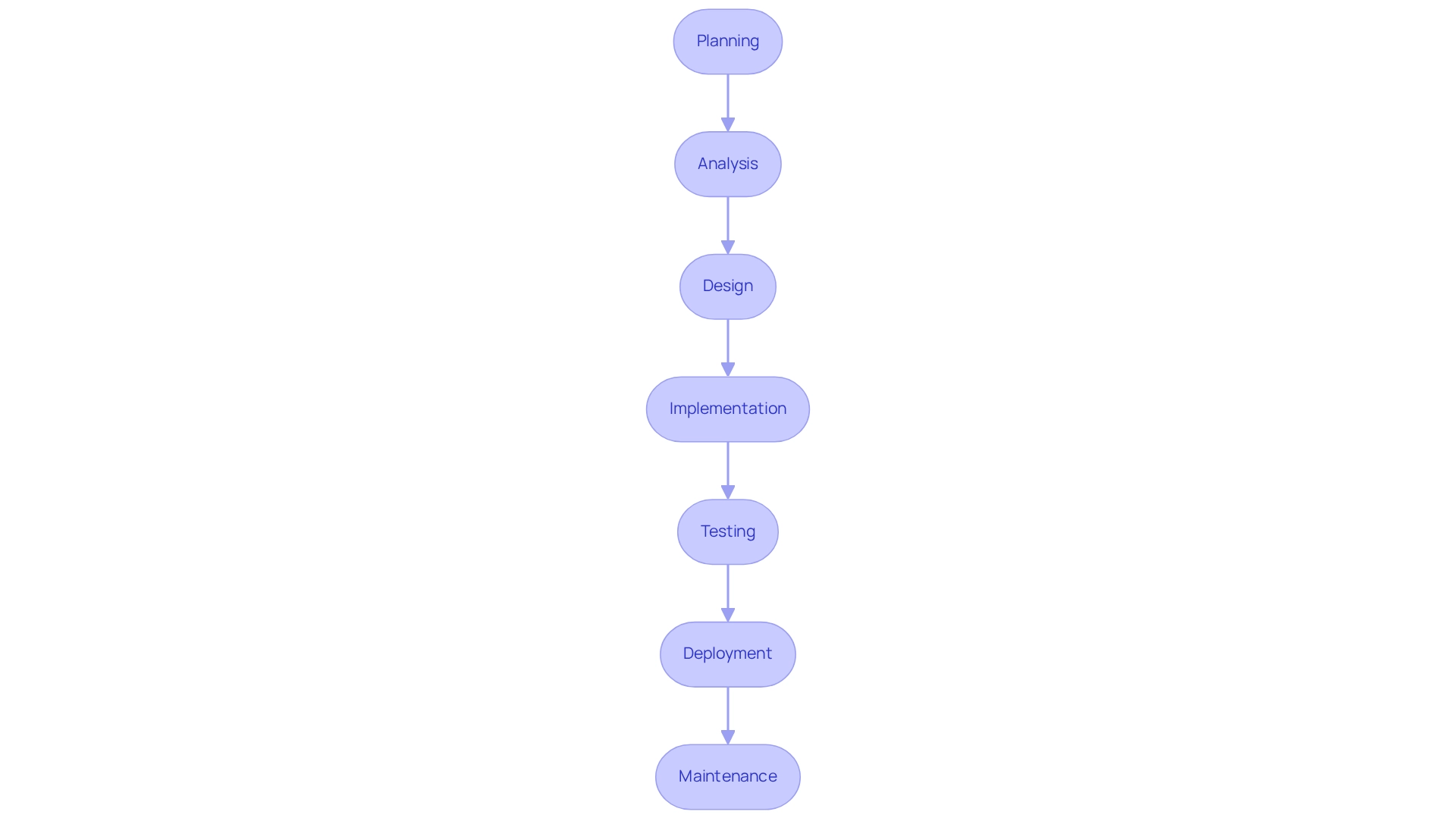
Phases of SDLC: Key Stages Every Developer Must Know
The critical stages of the Software Development Life Cycle (SDLC) are essential for ensuring successful outcomes. Each phase plays a pivotal role in the overall development process, addressing common challenges developers face.
- Planning: This initial stage involves establishing project goals and defining the scope, laying the groundwork for the entire project. Effective planning significantly mitigates challenges encountered later in the SDLC. As David Heinemeier Hansson suggests, focusing on fundamental aspects rather than attempting to master everything is crucial during this phase.
- Analysis: In this phase, developers gather requirements and analyze user needs. This step is vital as it directly impacts the design and functionality of the software. A well-executed requirement analysis can lead to more accurate project outcomes.
- Design: The design stage involves creating the architecture and design specifications. This includes outlining system interfaces and data structures, essential for guiding the implementation phase.
- Implementation: This stage encompasses writing and integrating code, where actual development occurs. Adherence to coding standards is critical to avoid complications later. Code generation should be approached cautiously to maintain clarity and ensure maintainability.
- Testing: In this phase, verifying that the software meets requirements and is free of defects is paramount. Evaluation ensures quality and functionality, with statistics indicating that thorough evaluation can reduce post-deployment issues by up to 40%. This underscores the importance of rigorous evaluation methods.
- Deployment: After testing is complete, the application is released to users. This stage requires meticulous planning to facilitate a smooth transition and encourage user adoption.
- Maintenance: Ongoing support and updates are necessary to keep the software functional and relevant. This stage addresses issues that arise post-deployment and incorporates user feedback for continuous improvement.
As Alan Turing once said, "Those who can imagine anything, can create the impossible." Understanding the SDLC methodology meaning is crucial for developers in 2025, as they navigate increasingly complex projects. Each stage contributes to the overall success of application development, which underscores the SDLC methodology meaning in achieving high-quality outcomes.

SDLC Models: Exploring Waterfall, Agile, and Iterative Approaches
The Software Development Life Cycle (SDLC) illustrates the sdlc methodology meaning through various models, each characterized by its unique approach to software development.
- Waterfall: This model adheres to a linear progression, necessitating the completion of each phase before the subsequent one begins. Its straightforward nature aids in planning and documentation; however, it can be inflexible, posing challenges when accommodating changes during a phase.
- Agile: In contrast, Agile employs an iterative approach that prioritizes flexibility and collaboration with customers. This model facilitates ongoing adjustments throughout the development process, fostering a responsive environment that adapts to evolving requirements. Recent trends reveal a notable shift towards Agile methodologies, with adoption rates increasing from 20% in 2020 to 31.5% in 2023, underscoring its rising popularity among organizations. As Tony Fadell aptly noted, "If you have fifty people who understand your culture and add a hundred who don’t, you will lose that culture," emphasizing the significance of team dynamics in Agile settings.
- Iterative: Similar to Agile, the Iterative model emphasizes repeated cycles of development. This approach encourages continuous enhancement and refinement, enabling teams to integrate feedback and gradually improve the application. The inherent rhythm in Scrum, a widely used Agile framework, aligns with human nature, promoting a more organic workflow.
Each model possesses its own advantages and disadvantages. For example, while Waterfall is beneficial for projects with clearly defined requirements, Agile and Iterative models excel in dynamic environments where requirements may shift. Case studies have illustrated that Agile methodologies markedly enhance team productivity and success rates across diverse industries, showcasing the effectiveness of iterative approaches in software development. As organizations continually evaluate their SDLC strategies, understanding the sdlc methodology meaning and the distinct characteristics of these models will be crucial for improving outcomes.
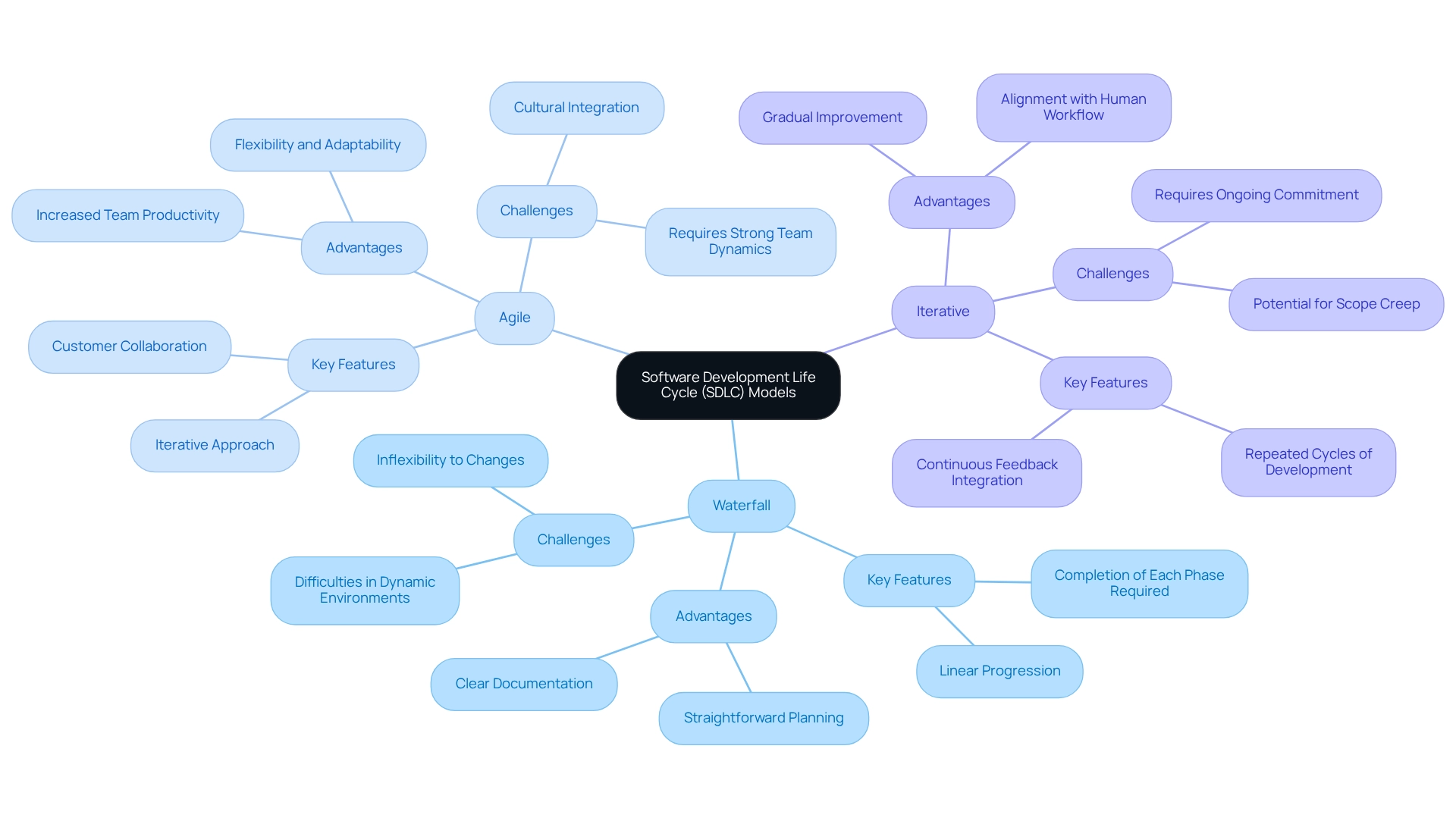
Planning Phase: The Foundation of Successful SDLC Implementation
The planning phase is essential for defining the scope, objectives, and deliverables, laying the groundwork for successful SDLC methodology implementation. This stage encompasses resource allocation, budgeting, and scheduling, which are vital for aligning goals with business objectives. A well-organized plan clarifies expectations for all stakeholders and identifies potential risks and challenges early on, enabling teams to develop effective mitigation strategies.
Did you know that nearly half of strategic initiatives fail due to misalignment between initiative objectives and business goals? This statistic underscores the critical need for thorough planning. Effective planning strategies involve setting achievable objectives and fostering clear communication among team members. As highlighted by the Project Management Institute, managers should prioritize effective planning, clear communication, and attainable objectives to ensure success. Furthermore, utilizing management tools can save an average of 10 minutes per day, illustrating the efficiency gained through structured planning processes.
Recent insights suggest that future studies should focus on measuring the ideal level of preparation necessary for favorable outcomes in application development. This encourages managers to evaluate their planning methods. Integrating risk management into the preparation stage is also crucial. For instance, recognizing potential risks early allows teams to take proactive measures, significantly reducing the likelihood of delays or failures. Overall, the planning stage is vital for enhancing organizational flexibility and ensuring successful execution in the ever-evolving landscape of application development.
Requirement Gathering: Defining What Users Need from the Software
Requirement gathering stands as a pivotal stage in the software development lifecycle (SDLC), which reflects the SDLC methodology meaning by focusing on the collection and documentation of user and stakeholder needs and expectations. By employing techniques such as interviews, surveys, and workshops, developers can gain a comprehensive understanding of user requirements. Consider this: efficient requirement collection can significantly enhance outcomes. A study revealed that only 55% of leaders feel business objectives are clear, highlighting an urgent need for improved communication and clarity.
Clear and detailed requirements act as a roadmap for the design and development phases, ensuring that the final product aligns with user expectations. As usability pioneer Jakob Nielsen emphasizes, "Pay attention to what users do, not what they say," which underscores the critical importance of observing user behavior during requirement gathering.
In 2025, the SDLC methodology meaning emphasizes the importance of user requirements more than ever. Statistics indicate that organizations prioritizing user satisfaction in their requirement gathering processes experience marked improvements in project success rates. Furthermore, 61% of high-performing organizations provide leadership training, illustrating the necessity of equipping teams with the skills needed for effective requirement gathering. By adopting best practices and the latest techniques in requirement gathering, developers can foster a collaborative environment that respects and empathizes with user needs, ultimately leading to more successful solutions. As Helen Keller noted, building relationships founded on respect and empathy is essential in this process.
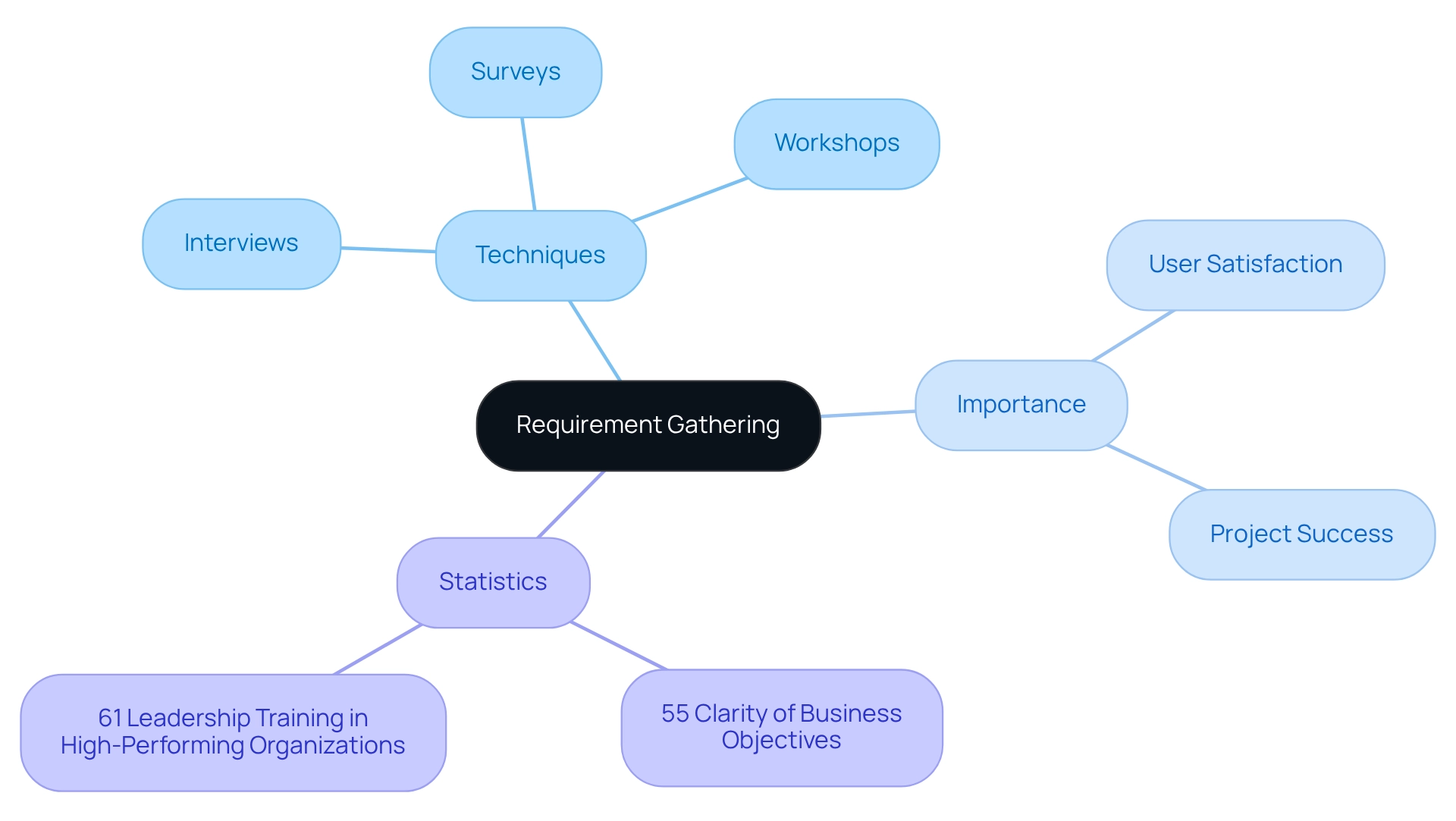
Testing Phase: Ensuring Quality and Functionality in SDLC
The evaluation stage plays a crucial role in confirming that software meets the outlined specifications. This phase includes:
- Unit evaluations
- Integration evaluations
- System evaluations
- User acceptance evaluations
Each serving distinct purposes. Unit evaluation focuses on individual components, ensuring they operate correctly in isolation. In contrast, integration assessment examines the interaction between different modules. System evaluation assesses the entire integrated application, while user acceptance assessment verifies that the application fulfills user requirements and expectations.
A thorough evaluation strategy is essential for delivering reliable, functional, and defect-free software. Did you know that up to 70% of defects are identified during the evaluation phase? This statistic underscores the critical nature of this stage in the context of the SDLC methodology meaning. Moreover, the Cost of Quality (CoQ) represents the overall expenditure required to attain and uphold product quality, highlighting the financial implications of efficient evaluation.
Improvements in application evaluation techniques, such as automated assessments and continuous integration, have significantly enhanced the efficiency and effectiveness of the evaluation process. Experts agree that a robust evaluation period not only improves product quality but also reduces long-term expenses related to post-release flaws. Implementing best practices for measuring software quality—such as aligning metrics with business goals—can lead to valuable insights for continuous improvement. For instance, establishing clear objectives and avoiding vanity metrics can ensure that metrics provide actionable insights.
As Aristotle wisely stated, "Quality is not an act, it is a habit," emphasizing the continuous commitment to quality in the evaluation phase. Real-world examples show that effective unit and integration testing can drastically reduce the number of defects found in later stages, ultimately ensuring a smoother release process.
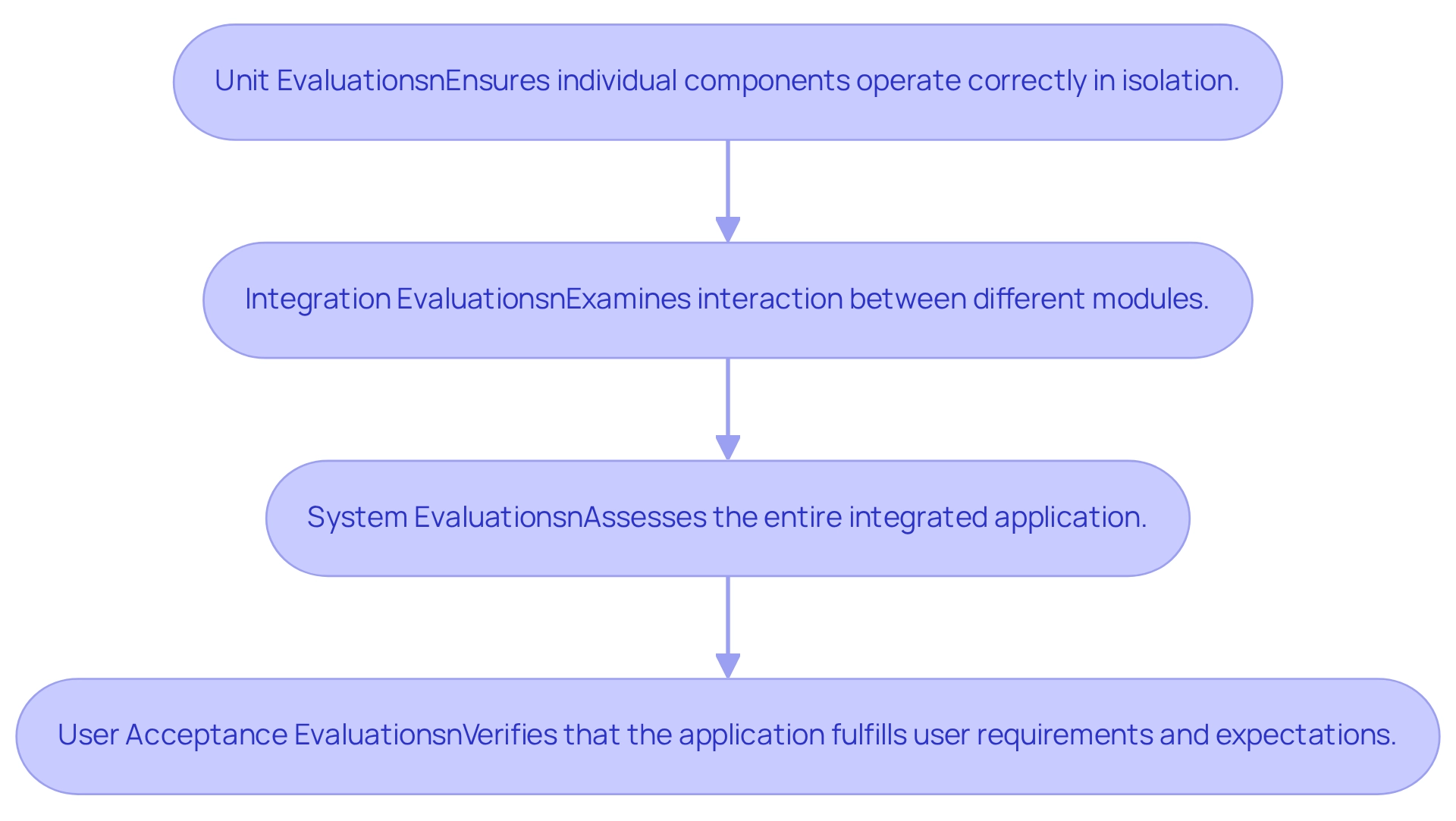
Deployment Strategies: Transitioning from Development to Production
Deployment strategies are crucial in transitioning software from development to production, significantly impacting the overall success of the process. The selection of a strategy often depends on specific project requirements and organizational practices. Consider some of the most common approaches:
- Big Bang Deployment: This strategy entails deploying all components at once. While it can be risky due to the potential for widespread issues, it provides immediate availability of the entire system. However, the chance of encountering significant problems increases, making thorough testing essential before implementation.
- Rolling Deployment: This method gradually replaces instances of the previous version with the new one. By doing so, it minimizes downtime and ensures continuous service availability. This strategy is particularly effective in environments where uptime is critical, allowing teams to monitor the new version's performance before fully committing to the switch.
- Blue-Green Deployment: This strategy maintains two identical environments—one active (blue) and one idle (green). When a new version is ready, it is deployed to the green environment. Once verified, traffic is switched from blue to green, facilitating seamless transitions and quick rollbacks if issues arise. This method greatly minimizes downtime and enhances deployment reliability, and current trends indicate that 72% of organizations focus on integrating security with observability and monitoring during deployments, which highlights the SDLC methodology meaning in relation to the importance of security in the development lifecycle. Additionally, 83% of developers engage in DevOps activities daily, emphasizing the integration of development and operations in modern deployment strategies.
Real-world examples showcase the effectiveness of these strategies. For instance, companies like MalwareBytes and Remitly have successfully implemented blue-green deployments to enhance cost allocation and reduce downtime. Such case studies illustrate the advantages and disadvantages of each strategy, aiding teams in making informed decisions based on their specific contexts.
In summary, grasping the nuances of deployment strategies—such as Big Bang, Rolling, and Blue-Green—enables developers to select the most effective approach for their projects, ultimately boosting productivity and code quality.
Maintenance Phase: Keeping Software Relevant and Functional
Developers often face significant challenges in maintaining their code after deployment. The maintenance phase is crucial as it encompasses continuous support and updates to the system. This includes fixing bugs, implementing new features, and ensuring compatibility with evolving technologies. Regular maintenance is essential for keeping applications relevant and functional, as well as for addressing issues that arise post-deployment.
With Kodezi CLI, B2B engineering teams can autonomously improve their codebase and resolve bugs before they reach production. This capability significantly enhances the maintenance process. Kodezi's AI-driven programming tool not only automates bug analysis and correction but also boosts productivity across more than 30 programming languages. Additionally, it supports Visual Studio Code, ensuring that applications remain robust and current.
Why struggle with coding challenges when Kodezi can streamline your workflow? To get started quickly, check out our 5-minute quickstart demo and discover how Kodezi can transform your coding practices.
Security in SDLC: Integrating Security Practices Throughout the Development Life Cycle
Security is a fundamental consideration that aligns with the SDLC methodology meaning throughout the Software Development Life Cycle. Have you ever thought about the coding challenges developers face today? By executing threat modeling during the design stage, applying secure coding practices throughout development, and conducting security testing during the evaluation period, developers can tackle these challenges effectively. Furthermore, integrating security practices into every phase of the SDLC methodology meaning allows for significant risk reduction regarding vulnerabilities. This not only ensures that the software is secure but also compliant with industry standards. The benefits of prioritizing security are clear:
- Improved software integrity
- Enhanced trust from users
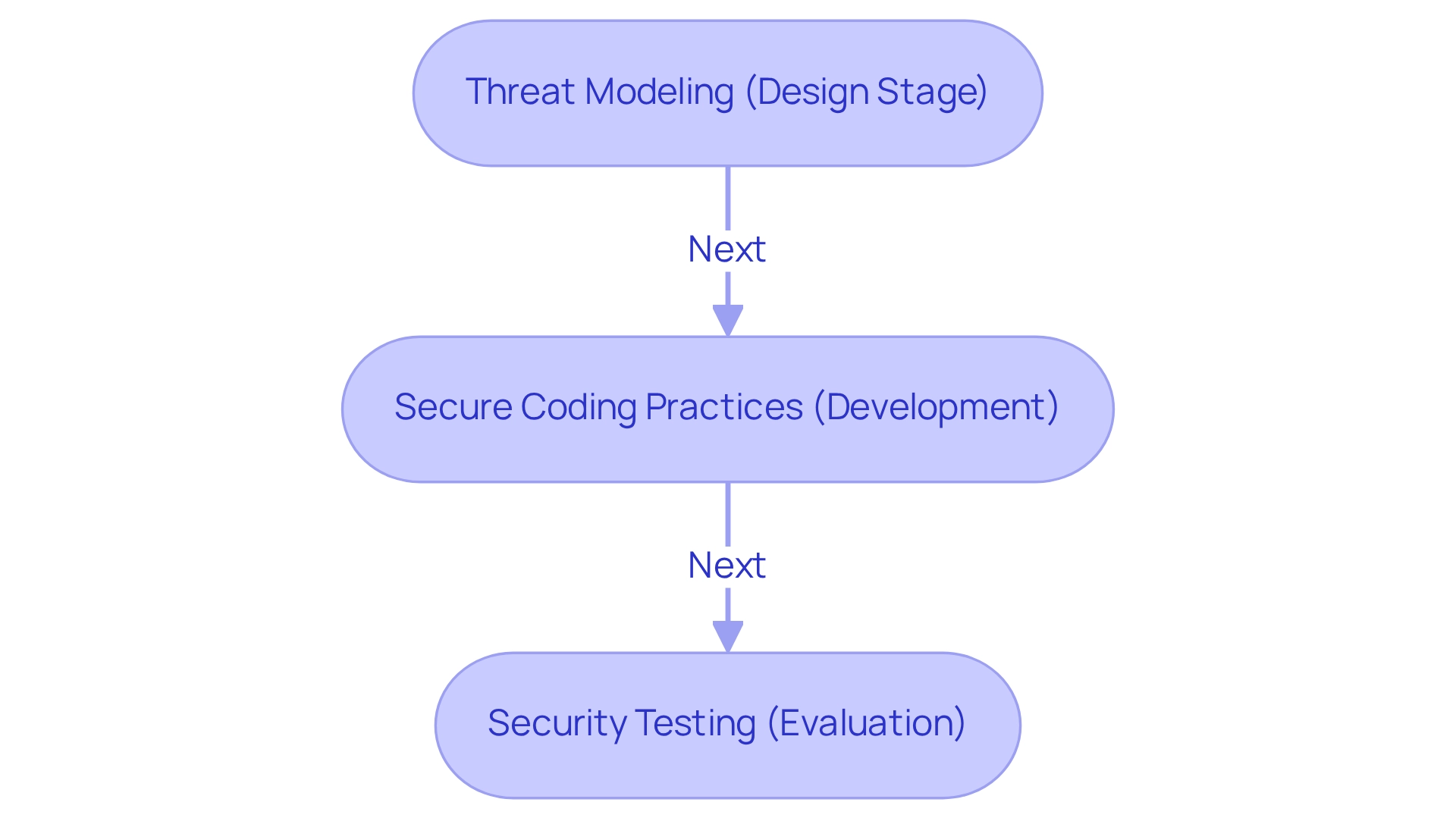
Conclusion
The exploration of the Software Development Life Cycle (SDLC) highlights the critical challenges developers face in delivering high-quality software applications. Each phase—from planning and requirement gathering to testing, deployment, and maintenance—serves as a vital building block that ensures software aligns with user needs and industry standards. As organizations increasingly embrace Agile and iterative methodologies, understanding these phases becomes even more essential for developers seeking to optimize their workflows and enhance collaboration.
Furthermore, the introduction of tools like Kodezi revolutionizes the development landscape. By automating API documentation and offering features that streamline coding practices, Kodezi empowers developers to focus on delivering exceptional software without getting bogged down by tedious tasks. For instance, the statistics highlighting the effectiveness of automated processes—such as faster return on investment and reduced feedback response times—illustrate the tangible benefits of integrating such tools into the SDLC.
In addition, the integration of structured methodologies and advanced tools like Kodezi not only enhances productivity but also elevates the quality of software solutions. As the software development landscape continues to evolve, embracing these practices is essential for developers aiming to meet the ever-changing demands of the industry. By prioritizing a comprehensive understanding of the SDLC phases and leveraging innovative tools, developers can pave the way for successful project outcomes and a more efficient development process.
Frequently Asked Questions
What is the Software Development Life Cycle (SDLC) methodology?
The SDLC methodology is a systematic framework that outlines the stages involved in creating applications, from initial concept to deployment and ongoing maintenance. It typically includes planning, analysis, design, implementation, testing, deployment, and maintenance.
What are the key stages of the SDLC?
The key stages of the SDLC are: 1. Planning 2. Analysis 3. Design 4. Implementation 5. Testing 6. Deployment 7. Maintenance
How does Kodezi assist in optimizing the SDLC processes?
Kodezi provides a Professional OpenAPI Specification Generator that automates API documentation generation, ensuring compliance with industry standards. This automation reduces documentation time, enhances collaboration among team members, and facilitates smooth transitions between SDLC phases, ultimately improving software quality.
What benefits can organizations expect from implementing automated documentation?
Organizations can expect a faster return on investment, with 78% anticipating returns within six months. Additionally, automated evaluations can reduce developers' feedback response time by up to 80%, leading to shorter development cycles and quicker time-to-market for new features.
What tools does Kodezi offer to developers?
Kodezi offers a suite of developer tools, including the Kodezi CLI, which helps teams auto-heal codebases and streamline workflows. It also enables the automatic generation of OpenAPI specifications and the creation of Swagger UI sites for testing APIs.
What recent trends are observed in SDLC methodologies among developers?
Recent trends indicate that smaller teams show a 78% preference for Agile methodologies due to their adaptability and responsiveness. In contrast, larger teams exhibit a balanced distribution between Agile and Waterfall methodologies, reflecting diverse project needs.
Why is continuous learning and adaptation important in the SDLC framework?
Continuous learning and adaptation are essential for navigating the complexities of application development. Experts emphasize that ongoing education, flexible approaches, and effective communication are crucial for overcoming industry challenges.
How can understanding the SDLC methodology benefit developers?
Understanding the SDLC methodology helps developers optimize their workflows, enhance collaboration, reduce errors, and improve overall productivity, leading to high-quality software solutions.




